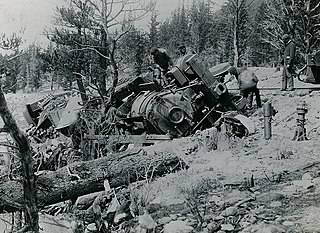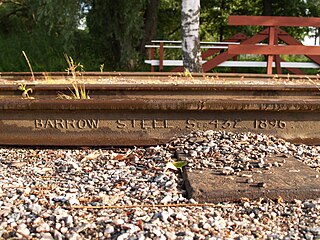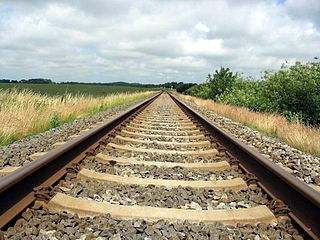
A track renewal train (also known as a track renewal system or new track construction machine) is a work train that consists of many units of machinery and materials required for track renewal (rail and sleeper replacement) projects.

A track renewal train (also known as a track renewal system or new track construction machine) is a work train that consists of many units of machinery and materials required for track renewal (rail and sleeper replacement) projects.
To minimize the time of track during a track renewal project, a track renewal train is used to automate most of the required process. Prior to the arrival of the track renewal train, preparation tasks must be completed. In some cases, the old rail needs to be cut into smaller segments and joined with fishplates. The rail fastening system may need to be released prior to its arrival. [1]
The new rails usually need to be prepared prior to the arrival of track renewal train. Rails are delivered to the center of the track. Those rail pieces are welded by track workers to form continuous welded rail (CWR) and left at the center of the track at the exact position required by the track renewal train to pick up at its arrival. [2]
A track renewal train has a series of machinery units that are combined into one train. As the track renewal train moves forward, the track renewal process will be done stage by stage to the completion of track renewal as it leaves the area.
The first stage of track renewal is the removal of old sleepers. The releasing rail fastening system from the sleepers may be part of this process. Some machines integrate the semi-automatic clip-releasing devices by hoisting such devices as part of the track renewal train to allow operators to manually position the device to each clip and trigger it to automatically release the clip. [3] Some units have a machine to automatically remove spikes in the older type of wooden sleepers. [2]
After rails are untied from the sleepers, those old rails will be lifted up and pushed toward the sides of the train. The new rails are also fed in near the sides of the train in preparation to be inserted.
The track renewal train has a machine that pulls the old sleepers out from the ballast. These old sleepers are delivered into the conveyors to move them out for storage at the rear of the train.
The ballast bed is then cleared in preparation of laying new concrete sleepers. In case there is a need to lower the ballast bed, the ballast excavating process will be done. This process is integrated into the track renewal train in some models. Excess ballast in that case will be moved out through the conveyor belt to the ballast storage area. Those old ballast materials will be screened and cleaned to be reused. The unusable ballast will kept in a separate storage to be discarded. [1] [4]
Some machines have an automatic track copying by recording the track geometry of the old rails prior to the removal, then the machine will calculate the exact amount to clear the ballast bed to prepare for laying new sleepers and rails to match to the original geometry of the old ones in term of cant, leveling and positioning. [5]
There are gantry cranes attached to the top of the track renewal train. These cranes run along the special side rails of the train. These special rails also connect between cars allowing operators to travel along the entire length of the train. The cranes are used to transport old sleepers into the storage area and bring the new sleepers into the working area.
The new sleepers are delivered by the cranes to feed into the machine. The machine puts sleepers onto the ballast bed and spaces them to the exact position required by specification. [2]
After the new sleepers are laid, the new rails will be pushed from the side of the train into position on the sleepers. To prevent rail stressing due to temperature fluctuations during normal operation, the rail will need to be laid at a precise temperature, based on anticipated operating temperatures. This is done by heater units of the track renewal train that warm the rails to the specification before laying on the sleepers. Another unit has an automated process to clip the rails onto the sleepers.
Depending on the models of the track renewal train, the old rail will be laid either inside at the center of track [5] or outside the new track at the shoulder [2] waiting to be picked up by another work train.
At the end, a large crane or conveyor belt with a magnet will be used to take all loose parts that have been left on the tracks to storage for reuse or recycling. The new track will be inspected prior to the ballast handling
After the track renewal train completes the tasks, the ballast will be put back on the track. For track renewal trains that do not have ballast excavating machines included, workers will use a shoulder ballast cutter machine that takes excess ballast that has been pushed out during the track renewal process, into a screening and cleaning machine. The reusable ballast will be put back to the new track together with the new ballast materials. For track renewal trains that do not include track copying or leveling, a ballast tamper will be used to make final adjustments to the track to the correct specification. A ballast regulator will then be used to make the final shape of the ballast.
Some track renewal train units have the ballast handling included such that the entire process of shoulder cutting, cleaning and placing of ballast is fully integrated. [1]
There was also another method of track renewal for double track area. Jarvis Rail invented a special type of machine called Slinger to run on the parallel track and deliver the pre-assembled track panels of up to 270 meters into the track to be renewed. This process was used in the United Kingdom. [7]
Here are some notable track renewal projects that use the track renewal trains:

A railway track or railroad track, also known as a train track or permanent way, is the structure on a railway or railroad consisting of the rails, fasteners, railroad ties and ballast, plus the underlying subgrade. It enables trains to move by providing a dependable surface for their wheels to roll upon. Early tracks were constructed with wooden or cast iron rails, and wooden or stone sleepers; since the 1870s, rails have almost universally been made from steel.

The railway track or permanent way is the elements of railway lines: generally the pairs of rails typically laid on the sleepers or ties embedded in ballast, intended to carry the ordinary trains of a railway. It is described as permanent way because in the earlier days of railway construction, contractors often laid a temporary track to transport spoil and materials about the site; when this work was substantially completed, the temporary track was taken up and the permanent way installed.

A railroad tie, crosstie, railway tie or railway sleeper is a rectangular support for the rails in railroad tracks. Generally laid perpendicular to the rails, ties transfer loads to the track ballast and subgrade, hold the rails upright and keep them spaced to the correct gauge.

In rail transport, a derailment is a type of train wreck that occurs when a rail vehicle such as a train comes off its rails. Although many derailments are minor, all result in temporary disruption of the proper operation of the railway system and they are a potentially serious hazard.

Maintenance of way refers to the maintenance, construction, and improvement of rail infrastructure, including tracks, ballast, grade, and lineside infrastructure such as signals and signs.

The Ruislip Lido Railway is a 12 in gauge miniature railway around Ruislip Lido in Ruislip, 14 miles (22.5 km) north-west of central London. Running from the main station at Woody Bay by the lido's beach, on a 1.02-mile (1.64 km) track around the reservoir, the railway passes through Ruislip Woods to Willow Lawn station and tea room near the lido's car parks. It is the longest 12 in gauge railway in the United Kingdom.
High-speed railway track construction is the process by which Lignes à Grandes Vitesses, the land on which TGV trains are to run, is prepared for their use, involving carving the track bed and laying the track. This construction technique is used both for the French TGV network and other TGV-based networks outside of France.

A tamping machine or ballast tamper, informally simply a tamper, is a self-propelled, rail-mounted machine used to pack the track ballast under railway tracks to make the tracks and roadbed more durable and level. Prior to the introduction of mechanical tampers, this task was done by manual labour with the help of beaters. As well as being faster, more accurate, more efficient and less labour-intensive, tamping machines are essential for the use of concrete sleepers since they are too heavy to be lifted by hand.

A work train is one or more rail cars intended for internal non-revenue use by the railroad's operator. Work trains serve functions such as track maintenance, maintenance of way, revenue collection, system cleanup and waste removal, heavy duty hauling, and crew member transport.

The rail profile is the cross sectional shape of a railway rail, perpendicular to its length.

A ballast cleaner is a machine that specialises in cleaning the railway track ballast of impurities.

A ballast regulator is a piece of rail transport maintenance of way equipment used to shape and distribute the gravel track ballast that supports the ties in rail tracks. They are often used in conjunction with ballast tampers when maintaining track.

A concrete sleeper or concrete tie is a type of railway sleeper or railroad tie made out of steel reinforced concrete.
VolkerRail is a specialist railway infrastructure services company based in Doncaster, England, providing services across the United Kingdom and Ireland. It is wholly owned by Netherlands-based VolkerWessels, a multi-disciplinary construction and civil engineering group.
Plasser & Theurer is an Austrian manufacturer of rail track maintenance and track laying machines.
A stoneblower is a railway track maintenance machine that automatically lifts and packs the sleepers with small grade ballast, which is blown under the sleepers to level the track. An alternative to the use of a ballast tamper, the totally self-contained machine levels track without the use of a large gang of workmen.
The Victorian Railways used a variety of former traffic wagons around depots and for specific construction, maintenance and similar tasks. Very few of these vehicles were specially constructed from scratch, often instead recycling components or whole wagon bodies and frames from old vehicles that had been withdrawn from normal service as life-expired or superseded by a better design.

Matisa Matériel Industriel S.A. is a Swiss company that manufactures rail maintenance machines and provides associated services. It was founded in 1945 and is based in the canton of Vaud.

Green track is a type of railway track in which the track bed and surrounding area are planted with grass turf or other vegetation as ground cover. It is a popular way of making railways more visually appealing, particularly for trams and light rail, and providing additional urban green space. Aside from the visual improvement, the vegetation provides a number of positive effects, such as noise reduction, less air pollution, rainwater runoff mitigation, and reduced urban heat island effect.